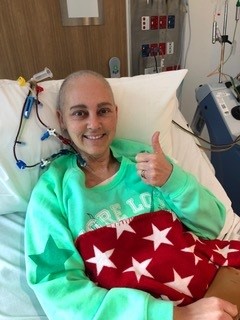Tahli is living proof new, targeted treatments for cancera disease where abnormal cells split without control and spread to other nearby body tissue and/or organs can work.
Diagnosed with lymphomacancers of the lymphatic system during the COVID-19 lockdowns, Tahli was hit with “bad news after bad news”.
Trying to run a business, homeschool her children and navigating strict lockdown restrictions, Tahli started losing weight and was getting more lethargic.
 Tahli with her dog
Tahli with her dog
When she developed little welts on her back and stomach, she assumed they were sandfly bites from her walks on the beach.
A doctor prescribed skin creams, which eventually settled the rash, but then Tahli developed a cough that wouldn’t go away. It took some extra persistence to see a doctor for a new cough during the pandemic, but Tahli knew something was wrong.
A chest X-raya type of medical imaging that uses x-ray beams to create detailed images of the body indicated pneumonia, but despite starting antibioticsmedication used to kill and/or slow the growth of bacteria, Tahli still wasn’t getting better. Finally, she was sent for a CT scan. Within two hours, and with no information, Tahli was told to head to the emergency department.
There, she was told her scan in fact showed lymphoma, she would need a biopsyremoval of a section of tissue to analyse for cancer cells, and an oncologista doctor who specialises in the study, diagnosis and treatment of cancer would be in touch. She went home, reassured her children everything was fine, and tried to get some sleep.
From there, Tahli started a whirlwind of scans, biopsies and began strong chemotherapya cancer treatment that uses drugs to kill or slow the growth of cancer cells, while minimising damage to healthy cells.
“The first few rounds I went in on a Monday, came out Saturday morning, 24/7 for five days straight,” she recalled.
 Tahli with her new hair
Tahli with her new hair
“Because I was in hospital I was away from my husband and kids, and that made it so much worse.”
Two rounds in came positive news – 90 per cent of Tahli’s tumoura tissue mass that forms from groups of unhealthy cells was gone. Tahli and her family started to hope treatment would be finished mid-year and life could return to normal.
Then more bad news came.
After four rounds of chemotherapy, a scan showed the cancer had grown. After the sixth round, another scan showed the tumour had grown again.
Tahli switched chemotherapy drugs for another two rounds, and had stem cellsthe basic structural and functional unit of all living things collected. Both took their toll mentally and physically, but even worse, the chemotherapy hadn’t worked at all, so the planned stem cell transplanta procedure that involves replacing unhealthy blood-forming cells (stem cells) with healthy stem cells couldn’t go ahead.
But there was hope.
Tahli had lung function tests and other procedures in preparation for a CAR-T therapy. With no idea what CAR-T was, she researched and watched videos online.
The treatment uses a type of immune cells called T-cells, that are reprogrammed to fight cancer.
While Tahli was found to be a good candidate for CAR-T therapy, at the time, the treatment she needed wasn’t listed on the PBS – but it was coming soon.
In the meantime, Tahli started radiation as her lymphoma was so aggressive. It made her feel even worse than the chemotherapy.
When it was finally time to start the CAR-T treatment, Tahli was feeling physically and mentally exhausted. Her oncologist told her this was her only hope.
“I looked at my family and thought, I don’t have a choice. It was all really scary, and you just hope that there’s no side effects,” she said.
Tahli became the first patient in Australia to have her particular CAR-T treatment when it was added to the PBS. Given her previous treatments had not worked, Tahli and her family went into it with low expectations.
Within 30 days of her treatment, finally, Tahli received the good news she’d been hoping and praying for – her disease had completely disappeared. For Tahli, it felt like a miracle!
Although CAR-T had some side effects, it was nothing like the struggles of chemotherapy and radiation Tahli had already endured.
On top of the physical side effects of her treatment, Tahli also faced mental battles, constantly feeling stressed about treatments that weren’t working and having to tell loved ones about her setbacks. She recalls asking her husband, “do you think I’m going to die?”.
Once, after finding friends to look after her children for what she expected to be a simple day clinic visit, she was hospitalised with a temperature and suspected infectiona condition where harmful pathogens, such as bacteria, viruses or parasites, have entered the body.
This was compounded with COVID lockdown, which meant when she went into hospital for her CAR-T treatment, she didn’t know when or even if she would see her children again.
Now, thanks to CAR-T therapy, Tahli is lymphoma-free and adjusting to life after cancer.
Every niggle or temperature can spike concern, along with the ever-present thought of lymphoma returning.
“It’s weird,” she said.
“No one talks about the after, they always talk about the during but not really anything after. There needs to be more information and education about survivorshipthe ongoing care and support people with cancer receive after cancer diagnosis and treatment. All of a sudden you go from having appointments and treatment every day to not having anything at all and returning to your new normal.”
